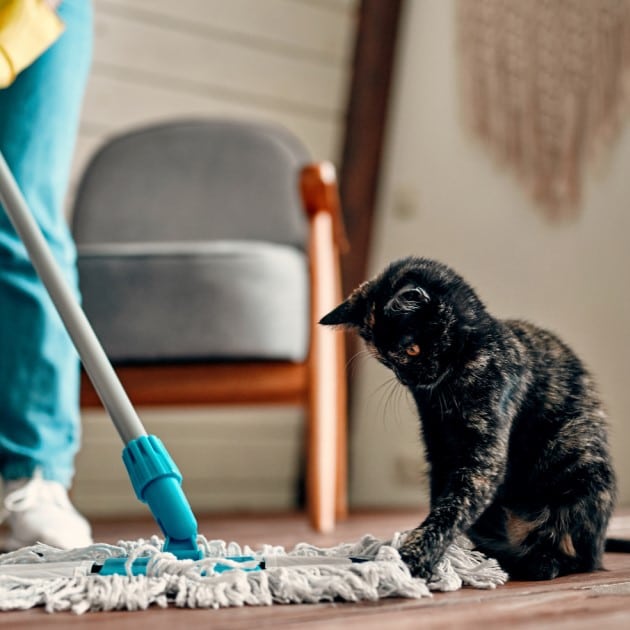I first realised how sensitive cats were when I was given a beautiful reed diffuser as a gift which I placed it in my bedroom. Not long after, I noted that one of the cats had been sick in the bedroom. As cats are hunters, I assumed it was something consumed eaten outside and a one-off. But it kept happening. Our second cat then started getting sick and so I started to consider other options. Remembering the diffuser, I removed it from the bedroom and the cats stopped being sick. I became interested in why the cats were so sensitive to this diffuser (the dogs had been fine) and it turns out there is a biological reason for this sensitivity, and it is all to do with their detoxification pathways.
Every day, ours and our pet’s bodies are exposed to toxins. They are produced internally in the body, like lactic acid and waste products from gut microbes, hormones, and neurotransmitters. But there also external toxins like air pollution, the chemicals from cleaning products or volatile organic compounds such as plug-in air diffusers. It is thought that in the 25 years between 1970 and 1995, the volume of synthetic organic chemicals produced tripled from about 50 million tonnes to approximately 150 million tons, and this number has grown year on year ever since. These toxins can disrupt essential biological structures in the body, whether human, dog, or cat. A toxin, by the way, is defined as any substance that must be neutralised and eliminated to avoid its promotion of ill-health if left to accumulate.
Detoxification is carried out by a range of mechanisms, and this comes in particularly handy as when one pathway is overwhelmed, another can take over. In a healthy system, toxins should always be able to find a way out. Initially, the body will attempt to detoxify at source. These locations include the intestinal mucosa, the respiratory mucosa, the microbiome, and the skin epidermis. Whilst these also provide a physical barrier to prevent toxin transport, they also express a range of enzymes which are essential in sweeping toxins away.
Then, detoxification falls into three phases. The first two phases are concerned with breaking down the toxin in the body, and phase three is concerned with excreting it. For us to manage ours and our cat’s or dog’s toxic load, all three phases need to be working optimally. In phase one we are mostly concerned with a range of enzymes. These enzymes attack the toxins and start breaking them down. It’s important to note that this phase generates high numbers of reactive oxygen species, or ROS leading to oxidative stress. So, the more toxins this phase must deal with, the more oxidative stress results. Once toxins have been passed through phase I, they are not yet finished with. Intermediate metabolites are produced, and they sit in the body. It’s almost like putting your rubbish in the outside bin, but missing collection day. The rubbish remains. Within phase two there are number of pathways, and they are all responsible for detoxifying different compounds and they include dealing with heavy metals, medications, mould, histamine, hormones, plastics, phenols, medications, antibiotics, smoke and more. Phase three deals with getting rid of them once and for all. This phase is carried out by the gut, skin, liver, and kidneys. All phases need to be working optimally for effective detoxification. Each phase is also incredibly nutrient demanding, so for healthy detoxification, our cats and dogs need a nutrient dense diet.
So, where does this leave our cats? It seems the domestic cat possesses certain genetic mutations which mean the above detoxification pathways aren’t as efficient as they need to be. We first started to learn more about this when we realised that cats have a particular sensitivity to phenolic drugs like acetaminophen (paracetamol) and aspirin. Cats demonstrate an inactivation of the gene responsible for the phenol detoxification enzyme. What’s even more interesting is that it’s thought that their diet played a role in this genetic glitch.
Phenols are found in plants and as cats are hyper-carnivorous (they get everything they need from animal tissue), there served no evolutionary reason for them to be able to process these compounds. Cats evolved to detoxify environmental threats, not plants they would never choose to eat, nor human-made synthetic ones (medications). This makes complete sense, but the problem is, this enzyme is involved in a larger pathway, which deals with things like steroids, hormones, plastics, mould, heavy metals, and other medications like non-steroidal anti-inflammatories. What this means is that cats metabolise these compounds at a much slower rate, meaning they are at risk of a build-up. This is why they appear more sensitive and are in fact at a higher risk of conditions like chronic kidney disease and hyperthyroidism.
Hyperthyroidism is widely accepted as the most common feline endocrine disorder. The thyroid gland is part of the endocrine system. It is a small butterfly shaped gland in the neck. One of the main functions is to produce hormones to regulate the body’s metabolism (the process that turns food into energy). These are more commonly referenced as T3 and T4. Hyperthyroidism is when the thyroid is hyperactive and there is an increased production of thyroid hormones. One theory of its cause includes the exposure to thyroid-disrupting compounds in the environment, drinking water or diet. Interest in this first appeared with the introduction of fire-retardant chemicals in many household items. The rates of hyperthyroidism seemingly increased with the introduction of these products.
The poor metabolism of toxins, including these fire-retardant compounds is thought to alter the structure and function of the thyroid gland. Not only that, but the slower metabolism of compounds, including hormones and therefore the slower elimination of T4 hormone, leads to high circulating levels. Where we really see the issue in their detox systems is when levels of toxins are noted as being higher in the cat than the human they live with; if it was simply environmental exposure, the human too would have the same levels.
With reference to chronic kidney disease, one of the main roles of the kidneys is to filter helpful and harmful compounds in the blood. It stands to reason that the more harmful compounds it must process, the sooner it reaches its retirement party. It is often suggested that chemical exposure is a progression factor in the disease. Cats are regularly exposed to cleaning agents, pesticides, and many more environmental toxins. These can be ingested, inhaled, or exposed through the skin.
Many cats are indoor cats, so they are constantly exposed to what we use in our home, such as: cleaning products, air fresheners, odour neutralisers, beauty products, bathing products, soft furnishing protectants, washing detergents, fabric softeners, floor cleaners, perfumes and fragrances. Airborne particles can attach themselves to fur and are then ingested when the cat grooms themselves. Whilst we may pop out to go shopping or even spend the day at work, for the indoor cat, they have 24-hour exposure, with a system that is already a little slower at metabolising modern day toxins. Luckily, we can limit their exposure, we can opt for non-toxic cleaning products, ditch the fabric softener, opt for a steam mop, and check the labels for any beauty or cleaning products we choose to use. I also recommend avoiding products which contain polybrominated diphenyl ethers, polyfluoroalkyl substances, bisphenol A (opt for glass bowls instead of plastic), parabens and phthalates. Consider using a HEPA air filter in the home to remove harmful particles from the air and vacuum regularly with a HEPA vacuum. Also consider the use of any long-term medications and how you can support their body to metabolise them, keep an open dialogue with your vet if you feel your cat is struggling with a particular medication.
Supporting their gut, skin, liver, and kidney function will also aid detoxification pathways. Cats are hyper-carnivorous, which means they have evolved to utilise animal tissues well. I would always advocate a fresh-food, carnivorous diet for the feline, offering the system exactly what it has evolved to process.
It goes without saying, but if you are concerned about your cat’s health then always seek the advice of a qualified professional.
Article by Lisa Hannaby-Aird. Lisa Hannaby-Aird is a psychologist, nutritionist, researcher, educator and author. Her first book is just about to go on sale. She can be contacted by email: lisa.hannaby@hotmail.co.uk



